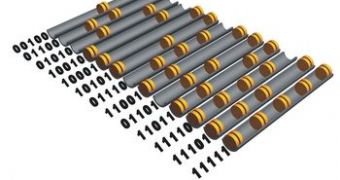So, the nanotechnology managed to develop nanomaterials of nanoflakes, nanowires, nanorods... but what about the nanodisks? They must be useful at something! Researchers from Northeastern University agreed and, in order to demonstrate their use, they developed a method that uses nanodiks carved out of nanorods to encrypt information in binary code, method that can be used for a number of applications such as tagging or tracking goods.
According to the material published by the researching team, the nanodisk structures work much in the same way as the traditional barcode readers, commonly used in most of the supermarkets, meaning that they react in an unique way when exposed to electromagnetic radiation, depending on the substance used to dye them.
Chemist Chad Mirkin, the leader of the project, explains how the research began by using gold and nickel nanorods, that were carved afterwards into nanodisks and paired in two, with another pair disk, in order to create a physical representation of a binary number containing up to five digits. Depending on the location of the disks on the rods, these can represent either the digit '0' or '1', meaning that, if the respective space allocated for the digit is occupied by a metal nanodisk, it will read as a '1', contrarily '0'.
For example, consider a five digit binary number. If one of the disks occupies the third position of the space allocated for the respective digit and the others are free, than the structure will read as the number '00100' equivalent to the number '8' in the decimal numeration system.
The main advantage of such devices is their low production cost and their size, and they can be easily read by using light spectroscopy techniques. The nanostructure can support nanorods up to 12 microns in length, that can contain about 10 individual nanodisk, which translates into 287 logical combinations. Furthermore, the research team is thinking of improving the functionality of the newly developed device by dyeing the disks with different molecules that would reflect light in an unique way when lit with an external light source, which due to traditional use and efficiency would most probably be a laser.
The unique light spectrum emitted during the illumination process makes the nanodisks encryption method extremely valuable for biological identification, for example. The Northeastern research team proved this concept, by attaching a strand of DNA on the surface of disk, thus sandwiching between a '11011' disk configuration, meaning that the DNA strand occupied the empty space represented by the digit '0'. Similar experiments involved '10101' disk configurations, both being successful at distinguishing between the two separate types of molecules present in the structure.

 14 DAY TRIAL //
14 DAY TRIAL //